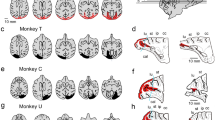Abstract
Two paradigms of memory-guided saccades were studied in 14 patients with focal vascular lesions affecting either the frontal eye field (FEF), or the supplementary eye field (SEF) or Brodmann's area 46 in the prefrontal cortex (PFC), and in 13 age-matched control subjects. In the first paradigm, the subject had to remember the position of a visual target with the body immobile and, in the second, the position towards which gaze was directed before a body rotation, i.e. with a vestibular input. In control subjects, the percentage of error in saccade accuracy (horizontal component) was greater in the second than in the first paradigm (37% and 14% on average, respectively). Compared with controls, amplitude error was significantly increased in the FEF group for the first paradigm only, in the SEF group for the second paradigm only, and in the PFC group for both paradigms. These results are consistent with (1) the PFC providing an improvement in the utilization by the saccade system of the visual and vestibular signals used in the two paradigms, and (2) the FEF and SEF providing an improvement in the utilization of visual signals in the first paradigm and vestibular signals in the second paradigm, respectively. Furthermore, from these findings and experimental data, it may be hypothesized (1) that the PFC is a part of the network contributing to short-term memorization of both visual and vestibular signals, and (2) that the FEF and SEF control two different types of memory-guided saccades, with separate calculation modes to determine their amplitude.
Similar content being viewed by others
References
Anderson RA, Bracewell RM, Barash S, Gnadt JW, Fogassi L (1990) Eye position effects on visual, memory, and saccade-related activity in areas LIP and 7a of macaque. J Neurosci 10:1176–1196
Barton EJ, Sparks DL (1992) Saccades to remembered targets exhibit enhanced orbital position effects in macaques. Soc Neurosci Abstr 18:701
Bloomberg J, Melvill-Jones G, Segal B (1991) Adaptative modification of vestibularly perceived rotation. Exp Brain Res 84:47–56
Bruce CJ (1990) Integration of sensory and motor signals for saccadic eye movements in the primate frontal eye fields. In: Signals and sense in cerebral cortex. Wiley, New York pp 261–314
Cavada C, Goldman-Rakic PS (1990) Posterior parietal cortex in rhesus monkey. II. Evidence for segregated corticocortical networks linking sensory and limbic areas with the frontal lobe. J Comp Neurol 287:393–445
Fox PT, Fox JM, Raichle ME, Burde RM (1985) The role of cerebral cortex in the generation of voluntary saccade: a positron emission tomographic study. J Neurophysiol 54:348–369
Funahashi S, Bruce CJ, Goldman-Rakic PS (1990) Visuospatial coding in primate prefrontal neurons revealed by oculomotor paradigms. J Neurophysiol 63:814–831
Gaymard B, Pierrot-Deseilligny C, Rivaud S (1990) Impairment of sequences of memory guided saccades after supplementary motor area lesions. Ann Neurol 28:622–626
Goldberg ME, Bruce CJ (1990) Primate frontal eye fields. III. Maintenance of a spatially accurate saccade signal. J Neurophysiol 64:489–508
Mann SE, Thau R, Schiller PP (1988) Conditional task-related responses in monkey dorsomedial frontal cortex. Exp Brain Res 69:460–468
Melamed E, Larsen B (1979) Cortical activation pattern during saccadic eye movements in humans: localization by focal cerebral blood flow increases. Ann Neurol 5:79–88
Mitz AR, Godschalk M (1989) Eye movement representation in the frontal lobe of rhesus monkeys. Neurosci Lett 106:157–162
Pierrot-Deseilligny C, Rivaud S, Gaymard B, Agid Y (1991a) Cortical control of memory-guided saccades in man. Exp Brain Res 83:607–617
Pierrot-Deseilligny C, Rivaud S, Gaymard B, Agid Y (1991b) Cortical control of reflexive visually guided saccades in man. Brain 114:1473–1485
Russo GS, Bruce CJ (1993) Effect of eye position within the orbit on electrically elicited saccadic eye movements: a comparison of the macaque monkey's frontal and supplementary eye fields. J Neurophysiol 69:800–818
Schall JD (1991a) Neuronal activity related to visually-guided saccades in the frontal eye fields of rhesus monkeys: comparison with supplementary eye fields. J Neurophysiol 66:559–579
Schall JD (1991b) Neuronal activity related to visually-guided saccadic eye movements in the supplementary motor area of rhesus monkeys. J Neurophysiol 66:530–558
Schiller PH, True SD, Conway JL (1980) Deficits in eye movements following frontal eye field and superior colliculus ablations. JNeurophysiol 44:1175–1189
Schlag J, Schlag-Rey M (1987) Evidence for a supplementary eye field. J Neurophysiol 57:179–200
Schlag J, Schlag-Rey M, Pigarev I (1992) Supplementary eye field: influence of eye position on neural signal of fixation. Exp Brain Res 90:302–306
Selemon LD, Goldman-Rakic PS (1988) Common cortical and subcortical targets of the dorsolateral prefrontal and posterior parietal cortices in the rhesus monkey: evidence for a distributed neural network subserving spatially guided behavior. J Neurosci 8:4049–4068
Shook BL, Schlag-Rey M, Schlag J (1990) Primate supplementary eye field. I. Comparative aspects of mesencephalic and pontine connections. J Comp Neurol 301:618–642
Sparks DL (1989) The neural encoding of the location of targets for saccadic eye movements. J Exp Biol 146:195–207
Stanton GB, Goldberg ME, Bruce CJ (1988) Frontal eye field efferent in the macaque monkey. J Comp Neurol 271:473–506
Van der Steen J, Russel IS, James GO (1986) Effects of unilateral frontal eye field lesions on eye-head coordination in monkey. J Neurophysiol 55:696–714
Author information
Authors and Affiliations
Rights and permissions
About this article
Cite this article
Pierrot-Deseilligny, C., Israël, I., Berthoz, A. et al. Role of the different frontal lobe areas in the control of the horizontal component of memory-guided saccades in man. Exp Brain Res 95, 166–171 (1993). https://doi.org/10.1007/BF00229665
Received:
Accepted:
Issue Date:
DOI: https://doi.org/10.1007/BF00229665



